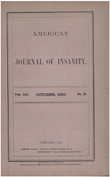Dynamic susceptibility contrast MRI of regional cerebral blood volume in Alzheimer's disease
Abstract
OBJECTIVE: The purpose of this study was to investigate the potential effectiveness of dynamic susceptibility contrast magnetic resonance imaging (MRI) to discriminate elderly patients with Alzheimer's disease from normal matched comparison subjects. METHOD: Images of regional cerebral blood volume (CBV) were generated from echo-planar MRI with the dynamic susceptibility contrast method in 13 Alzheimer's disease patients and 13 comparison subjects group-matched on age and gender. RESULTS: Temporoparietal cerebral blood volume, expressed as a percentage of the cerebellum value, was reduced 17% bilaterally in the patients with Alzheimer's disease. Blood volume in sensorimotor regions was reduced only 8.5% in the patients. Discriminant function analysis based on left and right temporoparietal measures correctly classified 88.5% of the subjects as patients or comparison subjects. Temporoparietal CBV was reduced even in mildly affected Alzheimer's disease patients (Mini-Mental State scores > 24). CONCLUSIONS: Dynamic susceptibility contrast MRI of regional CBV is promising as a nonradioactive, potentially lower-cost alternative to other functional neuroimaging methods for evaluating Alzheimer's disease.
Access content
To read the fulltext, please use one of the options below to sign in or purchase access.- Personal login
- Institutional Login
- Sign in via OpenAthens
- Register for access
-
Please login/register if you wish to pair your device and check access availability.
Not a subscriber?
PsychiatryOnline subscription options offer access to the DSM-5 library, books, journals, CME, and patient resources. This all-in-one virtual library provides psychiatrists and mental health professionals with key resources for diagnosis, treatment, research, and professional development.
Need more help? PsychiatryOnline Customer Service may be reached by emailing [email protected] or by calling 800-368-5777 (in the U.S.) or 703-907-7322 (outside the U.S.).



